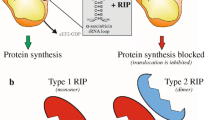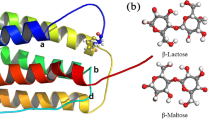Abstract
Background
Protein-based pharmaceuticals are among the fastest growing categories of therapeutic agents in the clinic and as commercial products, and typically target high-impact areas such as various cancers, autoimmune diseases and metabolic disorders. The aim of our work was to explore the possibility of reducing the level of aggregation and improve the stability of the recombinant proteins AIMP1/p43 (aminoacyl-tRNA synthetase complex component of the higher eukaryotes) and antitumor cytokine EMAP II (proteolytic cleavage product of AIMP1/p43) in combination with dextran-70 polysaccharide for structural–functional research and development of new sustainable biomedical products.
Methods
We studied interaction strength between these recombinant proteins with polymer by fluorescence spectroscopy and molecular docking.
Results
During experimental studies, optimal concentration ratio of AIMP1/p43 and EMAP II recombinant proteins with dextran-70 in which proteins bind to ligand and form complex was established. As a result of molecular docking investigations, spatial structure of the AIMP1/p43–dextran-70 and EMAP II–dextran-70 complexes was obtained and their binding energy was evaluation.
Conclusions
The effect of temperature increase on the stability of these two complexes was determined by fluorescence spectroscopy method. It was found that dextran-70 specifically connects with recombinant proteins. Binding stoichiometry of dextran-70 with protein is about 1:1, which confirms the formation of a specific complex.








Similar content being viewed by others
References
Wolfe CL, Warrington JA, Davis S, Green S, Norcum MT. Isolation and characterization of human nuclear and cytosolic multisynthetase complexes and the intracellular distribution of p43/EMAPII. Protein Sci. 2003;12(10):2282–90.
Shalak V, Kaminska M, Mitnacht-Kraus R, Vandenabeele P, Clauss M, Mirande M. The EMAPII cytokine is released from the mammalian multisynthetase complex after cleavage of its p43/proEMAPII component. J Biol Chem. 2001;276:23769–76.
Ivakhno SS, Kornelyuk AI. Cytokine-like activities of some aminoacyl-tRNA synthetases and auxiliary p43 cofactor of aminoacylation reaction and their role in oncogenesis. Exp Oncol. 2004;26:250–5.
Robinson JC, Kerjan P, Mirande M. Macromolecular assemblage of aminoacyl-tRNA synthetases: quantitative analysis of protein–protein interactions and mechanism of complex assembly. J Mol Biol. 2000;304(5):983–94.
Schwarz MA, Kandel J, Brett J, et al. Endothelial-monocyte activating polypeptide II, a novel antitumour cytokine that suppresses primary and metastatic tumour growth and induces apoptosis in growing endothelial cells. J Exp Med. 1999;190:341–54.
Ukrainian Patent No. 33215, A61К38/00, Published 10.06.2008, Bull. No. 11/2008.
Ukrainian Patent No. 64374, A61P 35/00, A61K 47/48. Published 10.11.2011.
Schwarz RE, Awasthi N, Konduri S, Cafasso D, Schwarz MA. EMAP II-based antiangiogenic-antiendothelial in vivo combination therapy of pancreatic cancer. Ann Surg Oncol. 2010;17(5):1442–52.
Schwarz Margaret A, Kandel Jessica, Brett Jerald, et al. Endothelial-monocyte activating polypeptide II, a novel antitumor cytokine that suppresses primary and metastatic tumor growth and induces apoptosis in growing endothelial cells. JEM Home. 1999;190(3):341.
Glick B, Pasternak J. Molecular biotechnology. Principles and applications. Moscow: Mir; 2002.
Babenko LA, Skorobogatov OY, Dubrovsky OL, Kornelyuk OI. Bacterial expression optimization of EMAP II antitumor cytokine in E coli BL21(DE3)pLys. Microbiol Biotechnol. 2010;3(11):21–31.
Vorobyova NV, Kornelyuk OI. Bacterial expression optimization of human AIMP1/P43 recombinant protein—a component of human multisynthetase complex in strain of Escherichia coli BL21(DE3)RIL. Mikrobiol Biotehnol. 2015;4(32):6–14.
Wright PE, Dyson HJ. Intrinsically unstructured proteins: reassessing the protein structure-function paradigm. J Mol Biol. 1999;293(2):321–31.
Dyson HJ, Wright PE. Intrinsically unstructured proteins and their functions. Nat Rev Mol Cell Biol. 2005;6(3):197–208.
Renault L, Kerjan P, Pasqualato S. Structure of the EMAPII domain of human aminoacyl-tRNA synthetase complex reveals evolutionary dimer mimicry. EMBO J. 2001;20(3):570–8.
Lakowicz JR. Principles of fluorescent spectroscopy. New York: Plenum Press; 1999.
Meyers RA. Encyclopedia of analytical chemistry. Chichester: Wiley; 2000.
Dubrovsky A, Braun J, Kornelyuk A, Murray J, Macuka G. Bacterial expression of full-length and truncated forms of cytokine EMAP II and the cytokine-like domain of mammalian tyrosyl-tRNA synthetase. Biopolym Cell. 2000;16(3):229–35.
Kordysh M, Kornelyuk A: Red-edge excitation fluorescence studies of the fast intramolecular dynamics of EMAP II cytokine. In: 15th IUPAB & 5th EBSA international biophysics congress; 2005.
Maniatis T, Fritsch E, Sambrook J. Methods of genetic engineering. Molecular cloning. Moscow: Mir; 1984. p. 479.
Laemmli UK. Cleavage of structural proteins during the assembly of the head of bacteriophage T4/U.K Laemmli. Nature. 1970;227(5259):680–5.
Trott O, Olson AJ. AutoDock Vina: improving the speed and accuracy of docking with a new scoring function, efficient optimization and multithreading. J Comput Chem. 2010;31:455–61.
Pettersen EF, Goddard TD, Huang CC, Couch GS, Pettersen EF. UCSF Chimera—a visualization system for exploratory research and analysis. J Comput Chem. 2004;25(13):1605–12.
Morris G, Huey R, Lindstrom W, Sanner M. Autodock4 and AutoDockTools4: automated docking with selective receptor flexibility. J Comput Chem. 2009;30(16):2785–91.
Vorobyova NV, Lozhko DM, Kornelyuk AI. Stability of human recombinant protein AIMP1/P43 in nanocomposite complex with beta-cyclodextrin. Bull Taras Shevchenko Natl Univ Kyiv Ser Biol. 2016;71(1):15–8.
Acknowledgements
The authors thank Professor Mark Mirande (Laboratoire d’Enzymologie et Biochimie Structurales, CNRS, France) for kindly providing plasmid pET28b-p43.
Author information
Authors and Affiliations
Corresponding author
Ethics declarations
Conflict of interest
The authors declare that they have no conflicts of interest to disclose.
Additional information
Publisher's Note
Springer Nature remains neutral with regard to jurisdictional claims in published maps and institutional affiliations.
Rights and permissions
About this article
Cite this article
Kolomiiets, L.A., Vorobyova, N.V., Lozhko, D.M. et al. Stabilization of AIMP1/p43 and EMAP II recombinant proteins in the complexes with polysaccharide dextran-70. Pharmacol. Rep 72, 238–245 (2020). https://doi.org/10.1007/s43440-019-00016-x
Received:
Revised:
Accepted:
Published:
Issue Date:
DOI: https://doi.org/10.1007/s43440-019-00016-x




